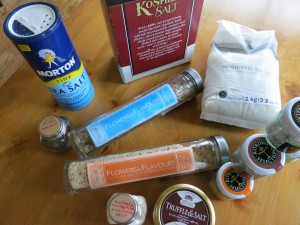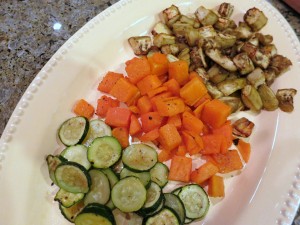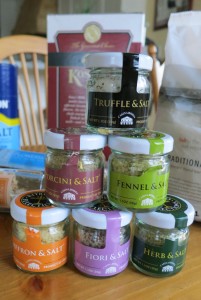Over the past year my pantry has been slowly populated with an unusual variety of salt – of various textures, blends and far-flung origins. I’ve been having fun sprinkling, cooking and learning. I’m not the only one.
I’d say salt is “the food gift” for 2012.
Friends are discussing, buying and giving salts. Even well-stocked grocery stores are selling unusual salts and salt blends. There’s a trend brewing. One friend brought me a beautiful Australian Murray River Pink Flake Salt and a potent Alderwood-Smoked Salish Sea Salt. She bought the salts in bulk from a Woodinville Washington company, SaltWorks, and packed them in small jars stamped with red reindeer.
Another friend will surprise her husband on Christmas with a large slab of pink Himalayan salt to cook on. You heat the slab to a high temperature and sear meat or other food right on it. You can also use it (unheated) as a serving tray for cheese or other foods (Also at SaltWorks).
Food science expert Harold McGee wrote in the New York Times (reference 1) that Himalayan salt is “likely to come from mines around 900 feet above sea level in the salt range of northern Pakistan…” Like a sommelier or trained wine expert now there are “selmeliers” to inform us about salt.
My husband ordered most of my exotic salts from his world-traveling wine purveyor, Garagiste. All summer I experimented with two versions of “Flowers and Flavors” coarse chunks of Italian sea salt, one blended with orange blossoms and another with a variety of Mediterranean flowers.
Sprinkled on vegetables or fish, sometimes with a little fennel pollen or other seasonings they offer up complex flavor, crunchy texture and a bouquet of flavor.
Beyond seasoning, these specialty salts bring romance and poetry to our cooking: “Salt is the sea that could not return to the sky” states the label of a 1-kilo bag of Slovenian traditional sea salt in my pantry.
So what is a dietitian doing talking about salt? The Dietary Guidelines for Americans 2010 (DGs) and other health policy makers say that we take in too much sodium which is linked to high blood pressure which in turn increases risk of heart disease and stroke.
The average American intake is about 3400 milligrams of sodium and the DGs recommend a reduction to 2300 milligrams per day (That is about 1 teaspoon of ordinary table salt.) and 1500 milligrams per day for about half the population, anyone over 51 or high risk individuals such as those with heart disease or African Americans. (Reference 2). How much sodium does the body need? Only about 250 to 500 milligrams. (Reference 3)
I agree that salt consumption is generally excessive in our society however most of it, about 75%, comes from processed and prepared foods. Only 10% comes from sodium naturally in food and 10 to 15% from the salt shaker (Reference 2). Therefore, when we cook at home with fresh, wholesome ingredients, we can enjoy some salt to enhance the flavor.
It is a fascinating substance. Salt enhances other flavors and masks the perception of bitterness. A pinch of salt can increase the palatability of nutrient-rich vegetables some people find bitter. Among the many roles of salt in food preparation, it prevents spoilage, tightens the gluten structure in bread-making and controls fermentation in cheese production.
Many salts have less sodium per teaspoon that ordinary table salt because they are diluted with herbs, minerals or other seasonings. Coarser salts have less sodium per teaspoon than finer salts, too. The sodium in 1 teaspoon of table salt is equivalent to 1 ½ teaspoons of Morton Kosher Salt or 2 teaspoons of Diamond Kosher salt.
Depending on how it is made, salt may be shaped as uniform crystals, flakes or a hollow pyramids (Reference 1). The particle structure, size and texture impacts how each salt tastes and how it works on foods and in recipes. Minerals, added flavorings or additives like anti-caking ingredients also contribute to the flavor and/or texture.
To trim sodium from your diet, read labels when you buy packaged foods; compare and select the lowest sodium option. Draining and rinsing canned beans can reduce the sodium by over one-third. When you cook at home, season just “to taste.” Dietitians will tell you that when people slowly start to use less salt, the palate adapts and they adjust to the new lower level. One easy tip – hold your hand up a little higher when you sprinkle on – less is delivered to the food.
The French have hand-harvested mineral-rich sea salt for ages. The delicate flavors and fine textures of these salts are often best savored as “finishing salts” sprinkled on just before serving. I have found this true with some of the flavored salts in my pantry.
I’ve recently played with saffron, fennel, porcini, herb and the aforementioned salts on flatbreads, in salads, vegetables and other dishes before and after cooking. Some work better as finishing salts and others withstand the heat of cooking – read the product label for tips or experiment. Hearty smoked salt and black salt (such as Hawaiian with activated charcoal) shine in rubs and spice blends for richer meats and grilling.
An all-time favorite, truffle salt, loses flavor when heat is applied so add it to dishes off-heat. One simple way to enjoy it or another salt blend is over your next bowl of popcorn.
References
1. A Pinch of Bali or a Dash of Spain by Harold McGee. The New York Times. April 27, 2011.
2. The Lowdown on Sodium in Your Diet. Environmental Nutrition, The Newsletter of Food, Nutrition and Health. Volume 35, p. 1 & 4.
3. Are You Salt-Smart? By Sidney Fry, MS, RD. Cooking Light Magazine. June2011 p. 45-51.
Copyright © Lorelle S Del Matto 2012



 About lorelle
About lorelle
They are not just an aphrodisiac (check out more aphrodisiacs here
along with a great three course menu for a romantic dinner for two) they are also
great for boosting testosterone (some might agree
the two go hand and hand). Some seniors function at a high level even into their eighties
and longer. Most of the articles you read deal
with estrogen and progesterone problems.
Hey just wanted to give you a quick heads up
and let you know a few of the images aren’t loading correctly.
I’m not sure why but I think its a linking issue.
I’ve tried it in two different internet browsers
and both show the same results.